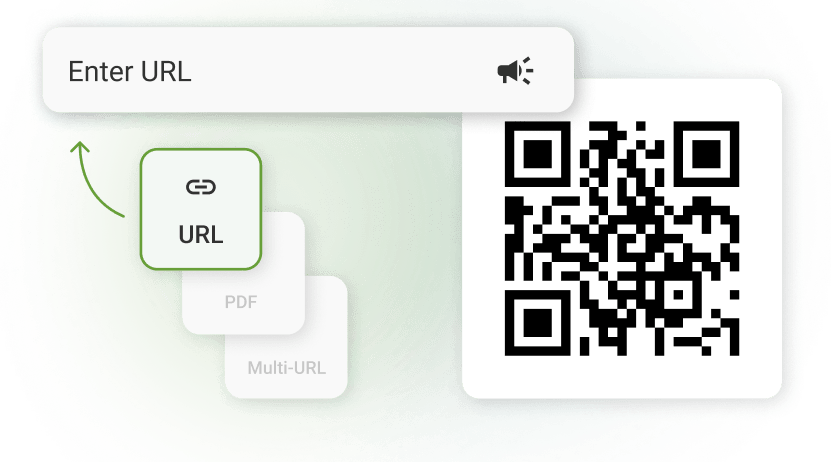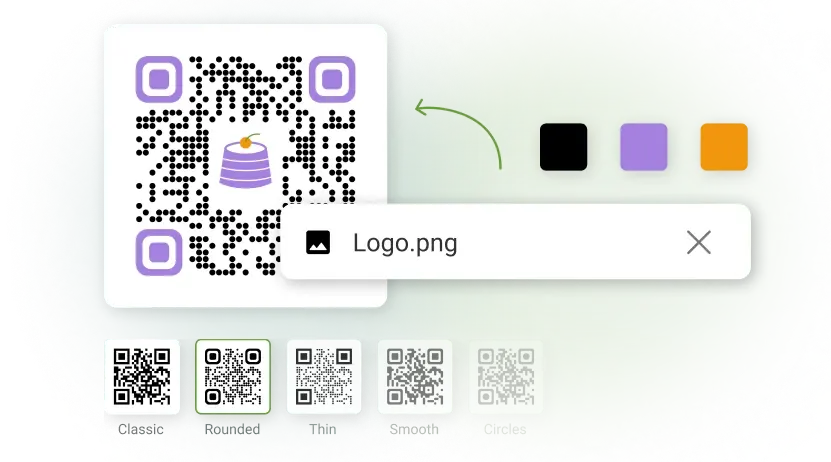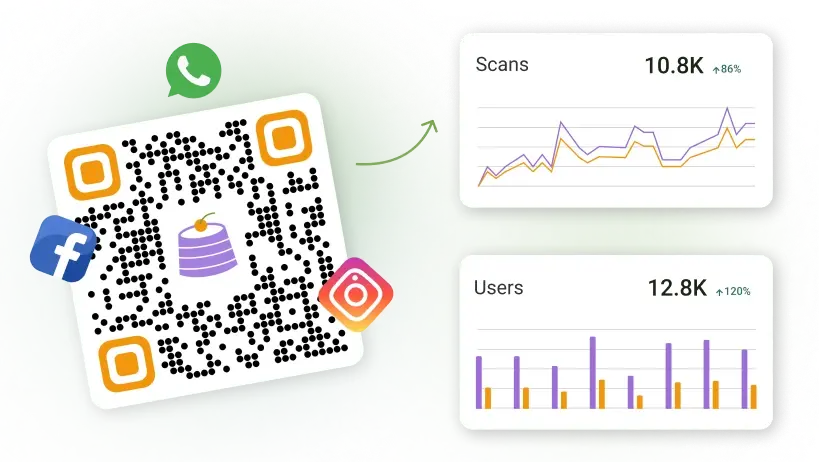Ever printed flyers or packaging only to discover your QR Code points to the wrong URL? You’re not alone. With static QR Codes, one typo or a last-minute campaign change can lead to dead links, wasted money, and frustrated customers.
The fix? Dynamic QR Codes. They let you update your destination URL anytime with no reprinting required. No broken links. No lost leads. No costly do-overs.
This guide will show you how redirect QR Codes work, why they’re better than using a short link, and how to future-proof your marketing with editable, trackable QR Codes.
Table of contents
- Can QR Codes be redirected once they’re live?
- How do you redirect your QR Code?
- How do various industries use redirectable QR Codes in campaigns?
- Scale smarter with redirect-ready QR Codes
- Frequently asked questions
Can QR Codes be redirected once they’re live
Only dynamic QR Codes can be redirected.
Dynamic QR Codes allow you to change the destination URL or content even after the QR Code has been created and printed. This flexibility makes them ideal for marketing campaigns, restaurant menus, product packaging, or any situation where information might change frequently. You can redirect users to new content with just a few clicks without reprinting or redistributing anything.
On the other hand, static QR Codes have a fixed destination URL that cannot be changed after printing. If the link breaks, the campaign shifts, or the content becomes outdated, you’re stuck. A new QR Code must be generated and reprinted, a costly and inconvenient process.
Some marketers try to get around this limitation by combining static QR Codes with a URL shortener, but that approach has its own problems.
Why using static QR Codes with short links isn’t a true solution
Some marketers try to “fix” the static QR Code problem by embedding a shortened URL (like Bitly) inside a static QR Code. Later, they update the destination link in the short link service to redirect scans elsewhere.
While this might seem like a clever workaround, it comes with hidden problems like:
- Losing access with subscription lock-in: If you stop paying for Bitly Premium, your links may stop working. All your QR Codes tied to those links can break instantly. You’re stuck paying just to keep them live.
- Damaging branding and trust: Generic short links like Bitly can look suspicious. They offer no hint of your brand or content, which makes users hesitate to scan.
- Missing key analytics: Bitly provides basic click data but not scan-specific insights. You won’t know what device was used or where or when scans occurred, limiting your ability to optimize your future campaigns.
- Complicating workflow with extra tools: Managing both Bitly and a QR Code generator adds unnecessary complexity. More tools mean more dashboards, more logins, and a higher chance of mistakes.
In short, using a static QR Code with a short link might delay the problem, but it doesn’t solve it. With dynamic QR Codes? You’re not just buying flexibility but also protecting your budget, time, and brand reputation.
So, how can you change a QR Code’s link after it’s made?
How do you redirect your QR Code
Here are the steps to create a QR Code that can be redirected to any URL at any point in time:
- Step 1: Go to The QR Code Generator (TQRCG) and select Sign up free. You’ll get a 14-day free trial with all the premium features.
- Step 2: Once you have signed in, select + Create QR Code, and in the field, paste the URL for which you want to create the QR Code.
- Step 3: Make sure the toggle for Dynamic QR Code is on, and after pasting the link, select Next.

- Step 4: Once you have selected Next, you can customize the QR Code according to your requirements. Then, Save it.

Once your dynamic QR Code is saved, you can go back and change the URL any number of times.
- Step 5: View your created QR Code on the Active Codes dashboard. Select the three dots on the right side and select Edit to redirect the QR Code to another link.
- Step 6: You will be directed to the same page as in Step 2, where you can insert your new link. The QR Code, printed or not, will be updated automatically.
Furthermore, you can go to the Analytics tab to check your scan data, such as unique users, devices used, locations, cities, time of day, country, etc.
Why use The QR Code Generator (TQRCG) to redirect QR Codes?
With TQRCG, you don’t need to reprint QR Codes if your links change. Simply find your code in the dashboard, update the URL, hit save, and you’re all set. Your QR Code stays functional, future-proof, and fully reusable.
Most platforms restrict dynamic QR Codes to trials and then deactivate them. With TQRCG, you can create two dynamic QR Codes without expiration, to redirect and track them indefinitely.
How do various industries use redirectable QR Codes in campaigns
Redirecting URLs and tracking all scan data make dynamic QR Codes the go-to tool for industries running time or location-based campaigns. If you’re updating promotions, refreshing content, or rotating menus, redirectable QR Codes let you adapt quickly without starting from scratch.
Let’s take a look at how different industries can put them to use in real-world campaigns.
1. Events and sports
Event organizers can redirect QR Codes on tickets, lanyards, or banners to keep attendees informed as schedules or venues change.
Campaign ideas:
- Redirect QR Codes on event lanyards for schedule updates.
- Update booth QR Codes with live leaderboards during marathons or esports events.
- Link attendees to post-event surveys or highlight reels after the event ends.
Example: Adidas used dynamic QR Codes during its Billboard Run campaign in Stockholm to redirect participants to leaderboards and event updates in real time, keeping the experience dynamic without replacing physical signage.
2. Retail and consumer brands
Dynamic QR Codes allow retailers to run seasonal or rotating promotions using the same printed QR Code on packaging, posters, or receipts.
Campaign ideas:
- For product packaging, link to “New Arrivals” now, and redirect to “Holiday Sale” later.
- Update QR Code URLs to current discount codes or event RSVP pages in store signage.
- Redirect the QR Code on receipts to updated claim forms or rewards offers.
Example: Coca-Cola used dynamic QR Codes on product packaging to shift from an interactive quiz to new promotional experiences as their The World Needs More Santas campaign evolved, maximizing already distributed products without waste.
3. Healthcare
Healthcare providers and educational institutions can use redirect QR Codes on brochures, posters, or medication packaging to ensure patients and professionals always access current information.
Campaign ideas:
- Redirect to updated vaccine appointment forms.
- Share new educational videos or guidelines without reprinting patient materials.
- Update training modules linked from QR Codes on educational posters.
Example: A scoping review in BMC Medical Education found that QR Codes, especially dynamic ones, can be used to update training resources and track engagement in real time. This allows healthcare educators to deliver timely content while measuring how learners interact with it.
4. Education
Schools and universities can keep information current by using dynamic QR Codes on campus maps, event posters, and orientation materials.
Campaign ideas:
- Update campus map QR Codes with detour information during construction.
- Redirect event QR Codes to last-minute room changes.
- Link to the latest student resources or emergency information.
Example: Universities use dynamic QR Codes on signage to keep students updated without reprinting materials every time information changes.
Scale smarter with redirect-ready QR Codes
Redirectable QR Codes are no longer a nice-to-have. They’re essential for any brand that values flexibility, tracking, and long-term engagement. Whether you’re managing marketing campaigns, product packaging, or educational resources, dynamic QR Codes let you adapt quickly without ever needing you to reprint.
And if you’re already using dynamic QR Codes, it is worth exploring how much more you can do with them
With The QR Code Generator (TQRCG), you can do more than just update links. It gives you tools that help you get real results from your QR Codes:
- See when, where, and how people scan your codes with in-depth analytics
- Organize your codes using folders and campaigns
- Compare scan numbers to track what’s working and what’s not
- Learn what devices and locations your audience is scanning from
If you run many campaigns, work with a team, or want to get more value from your marketing, these features can help. You’ll go from simple QR Code updates to smarter, data-driven decisions, all in one place.
Redirecting a link is just the beginning. With the right tools, your QR Codes can help grow your business.
Frequently asked questions
Yes, you can change a QR Code after printing only if it’s dynamic. With TQRCG, you can edit the destination link anytime without reprinting.
No, you don’t need to pay any additional fees if you opt for TQRCG’s dynamic QR Codes. The free plan includes two editable QR Codes. Premium plans add more features, but your codes remain editable.
Yes, with a dynamic QR Code, you can redirect to multiple links.
Absolutely, yes, you can track who scans your QR Codes. TQRCG provides detailed analytics, including scan time, location, device type, and operating system—all in your dashboard.
No, dynamic QR Codes are not slower than static ones. Redirections happen instantly in milliseconds. Users experience no delay or difference.
Dynamic QR Codes created with TQRCG never expire as long as they are active in your account, making them ideal for long-term campaigns.
Unfortunately, you’ll need to reprint them. This is why dynamic QR Codes are essential. They’re future-proof and always functional.








